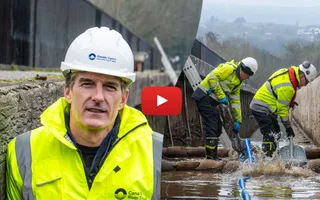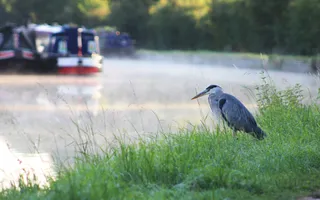The peace, the quiet, the escape from it all, the wildlife that call this home. The endless miles of canal and river. The special places we all can roam.
But hang on a minute. Who looks after it all? These people do. And they need your help.
Every winter, the Canal & River Trust has to spend a huge amount of time,
effort and money fixing, refurbing and upgrading the tired and broken bits
of our wonderful, world-renowned canal network.
Come along and have a look, they said. So here I am. Welcome to Lock 74.
So Paul, what is wrong with this lock?
Well, there's a lot of things wrong with this particular lock. It needs two new sets of gates. Quadrant needs repairing, new copers. It needs grouting because it's actually leaking onto the boats as they're coming through.
Loads of brickwork pointing to be done. It's all done with lime mortar, as it was built when it was built 200 years ago.
There's a bridge at the bottom, and that's going all the way down
to Gloucester to be repaired.
How long will this refurb take?
It'll take six weeks to do. And then it should last another 20 years. A lot of work to be done on this one.
Now, this is what I call a drill bit. And this is a short one. That's a small one.
You're the leak busters? Basically. Yes.
Majority of our work is egress, where we've got leaks coming out of the canal in rural areas, into fields, and into the more urban areas where
it might be coming out into a factory or a building or into someone's garden.
So you're drilling from inside out to do what?
We're trying to find one of the leaks coming back in to the chamber.
These are the pissers. So this is when you go water on the outside of the canal wall that's finding its way in, and it's literally like a spurt. Correct.
Right. So the treatment process for that is to do what?
We'll drill a hole along the line and then we'll inject to PU grout a polyurethane grout. It's an expanding foam, approximately about 400 pounds a tonne.
So you could end up with thousands going into one pisser.
Correct.
So where is lock 74?
It's on the Trent & Mersey, England's very first long distance canal, built in the late 18th century and 93 miles through the Midlands from end to end.
So very handy for potters like a certain Mr Wedgwood to get his precious porcelain to the port of Liverpool.
So this lock historically and today sees a lot of use?
Oh, absolutely. Very, very busy stretch. Very busy stretch. You get a lot of people coming from: Anderton, Acton Bridge direction. They're coming through here because a lot of people want to go on the Llangollen Canal because they want to go over the aqueduct.
So this is the main route from north to that area. We've had a lot of troubles over the last couple of years with the deterioration of the lock.
Hopefully, that'll all be cured now. Without the work that the Canal
& River Trust does now as a charity, I'm pretty sure that a great deal of the system would be derelict.
So why is Lock 74 so important?
It's an example of a surviving 1770s infrastructure. The footbridge was
originally the means of crossing the canal without crossing over the lock gate itself.
But it was a split bridge built in two with a gap in the centre of the arch.
So the rope which is pulling the boats could pass through. The current condition of the bridge is really poor, there is rot in the timber footboards. Significant rust damage to the ironwork itself. And there's layers and layers of paint, so we're unable to see some of those original details.
This is an important lock. You want to preserve the heritage. You want to preserve the history?
Absolutely. Yes. We're reinstating an original detail so we can once more tell the stories
of the past for future generations.
Right. Let me very quickly take you through the anatomy of the lock. The canal, the water is on the other side of this temporary shuttering. And this pump is helping stop me from drowning.
This area is called the forebay.
And these little alcoves on either side are called paddle holes. Because this is where the paddles live. They are essentially the sluice gates
that need to go up to let the water down the sluices.
The frame for that gate seals against is here. These are quoins either side, and this is the sill.
Down here is the heart of the lock. It's called the chamber, in this case, 75 foot long, 8 feet wide.
Down here, when you open those paddles, the sluice gates to fill the lock with water, the water comes flying out of these two holes at quite a rate of knots.
And at the bottom end of the lock, these two massive five meter tall gates. They've got little windows in the bottom with paddles. Here's the new ones, which again, you can pull up by winding, which lets the water out of the lock when you need to bring your boat down to be able to exit.
But when you dry one of these locks out, you find all kinds of stuff inside,
including like this: one not very careful owner.
So this is one of the old gates, and you can see why it needed to be replaced.
The bit that was always in the water down at the bottom of the gate,
which is the far end, is pretty solid. But then as you come up towards the top of the gate here, it gets more and more rotten.
It's obviously being serviced a part of its life, but now it's gone too far.
So, brand new ones have been crafted at a dedicated lock gate making workshop in Stanley Ferry near Leeds.
With over 1500 locks across the canal network, the specialist joiners here are never twiddling their thumbs.
The new oak gates for lock 74 are stunning.
Perhaps surprisingly, the key to fitting them so they don't leak is a pot of red paint.
So what's the point of this? Just to make the gates watertight?
To transfer the paint onto the gates onto the line is here. Then we can see where we've got high spots and low spots. Then for the water pressure.
So this is the brand new gate? And then it's got these old liners,
these strips. That's actually the seal? When this shut you'll get paint on the high spots and the low spots you get nothing?
Yeah, that's correct.
And then we'll just whip it over them with the electric play on some of the really high spots.
And then the block plane comes in to hand on the final finish. We want to try to get as much paint around these liners as possible.
So you then got a consistent amount of paint all the way around.
Then you know it's sealed?
Yes, that's correct, Ash can put the prop on the other side now to act as the water pressure. And then we open the gate back up.
So this paint then, what is it?
It's children's play paint, basically. So we used to use raddle.
So you're talking raddle, that rams used to mark ewes when they mated with them. They wear the harness with the raddle on, the coloured raddle.
Yeah. We used to just water that down and then transfer it on to the quoins.
Really? So it's just readily available, I guess? And you just bring the ram back, rub them up and down the post, and we'll be sorted.
It's exactly the same process to seal the bottom gates. Only there's two of them, they're way bigger, and there's over three and a half tonnes each, much heavier.
First, they need hanging.
So this gate's already on, a brand new gate in place, is sorted. This one's going to get dropped in now from the crane.
It's a long way up isn't it? So how does this hinge then?
That's the old one that came out of the original gate that was in here before.
But she's probably better than 20, 25 years. Wow.
It's a very, very simple and actually very small hinge.
So that's the ball of the joint, the pentil.
And that then slots into the socket down there, and it would sit in the socket. And then it can rotate. But also it can move slightly sideways, which is really clever.
You've got that small pentil at the bottom as the bottom hinge and at the top it's just literally that collar.
That collar with a pocket between that steel and the up post and a bolt going through holding the door altogether.
It's a very lax joint. The whole thing is very lax.
And it gives it that freedom for the water
to shut the gates into seal. And they can move to be able to adjust,
almost like in the self-adjusting gates.
Yeah, that's that right. Simple but clever.
How much do these gates cost? Around 50,000, for the pair.
That's a lot of money.
25 years. But every 25 years you have to do it again.
That's why you guys need so much funding and money. Because it's just, this is just never ending. If you want to keep the canals alive, you just got to keep feeding and feeding and feeding the money. For the maintenance, the fixes, the upgrades.
That's right.
Otherwise, the whole system just falls apart.
A couple of weeks later and with the lock fully refurbished, Paul and the engineering team re-water and reopen it for boaters. Lock 74 is back in service.
The canal network in England and Wales is an engineering masterpiece,
but it's really old and takes a lot of looking after, keeping everything safe and working as it should, so millions of us can all enjoy. It is a massive, never ending, hugely expensive job.
You know, there's no way the people who built and worked these locks over 200 years ago could possibly have imagined how busy they would still be today.
And it's major engineering works like this that keep their canals alive.
It is a massive effort and you can help.
You can take action and make a difference by supporting our work with a gift today.
You can easily donate by scanning the QR codes on the screen.
Alternatively, text CANALS8 to 70460 to give £8.
Text CANALS12 to 70460 to give £12.
Text CANALS20 to 70460 to give £20.
Your gift today will help us to protect your local waterways for future generations and help canals thrive.










